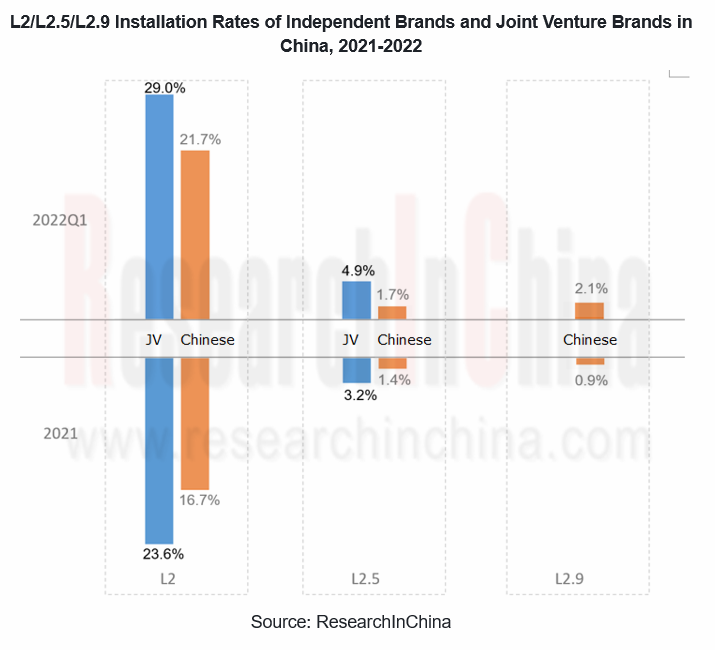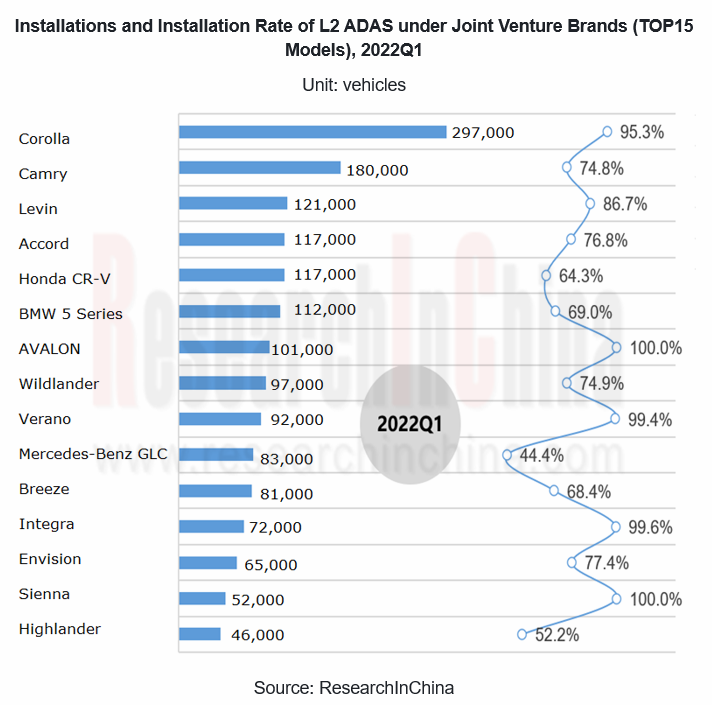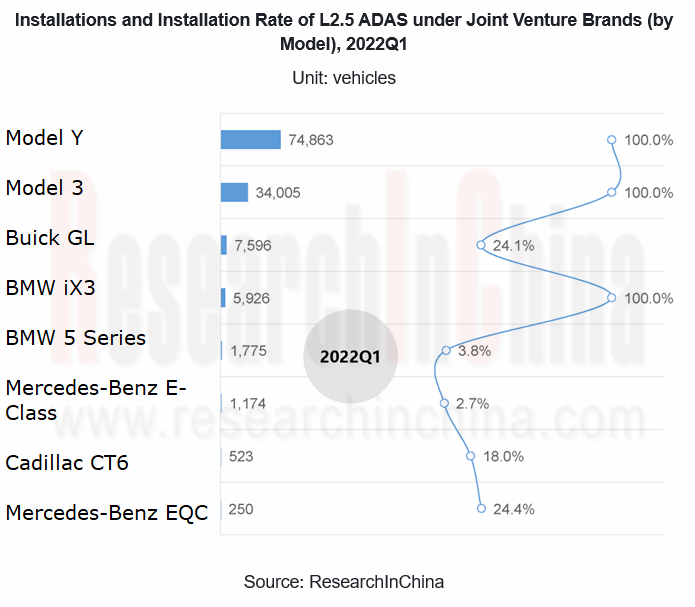Chinese Joint Venture OEMs’ ADAS and Autonomous Driving Report, 2022
Joint Venture OEM's ADAS Research: Joint venture brands lead in L2/L2.5 installation rate, but have not involved L2.9 for the time being
Following "Chinese Independent OEMs’ ADAS and Autonomous Driving Report, 2022", ResearchInChina released "Chinese Joint Venture OEMs’ ADAS and Autonomous Driving Report, 2022", which summarizes current ADAS and autonomous driving market status (installations, installation rate), functional applications, and market layout of China's top joint venture OEMs.
1. Joint venture brands lead in L2/L2.5 installation rate, but have not involved L2.9 for the time being
From the perspective of installation rate, the L2 and L2.5 functions of joint venture brands surpass those of independent brands by 7.3 percentage points and 3.2 percentage points respectively (data in 2022Q1). However, joint venture brands have not involved L2.9 for the time being, without similar functions offered by NIO NAD and Xpeng NGP.

At present, joint venture brands mainly compete in L2 field. Toyota's Corolla, Camry and Levin, Honda's Accord and CR-V as well as BMW 5-Series dominate the L2 market.
In terms of mainstream functions, joint venture brands further upgraded full-speed ACC, AEB with pedestrian recognition and other functions in 2022, with TJA and ICA as the highlights.
As for sensor solutions, 1R1V is the mainstream solution of L2 ADAS under joint venture brands, and 3R1V is the advanced solution. Compared with 2021, OEMs achieved functional advancement by adding radar in 2022. For example, Volvo, Toyota, and Honda upgraded 1R1V to 3R1V, and Ford improved 3R1V to 5R1V.

L2.5 is a new arena for joint venture brands. Tesla Model Y/Model X, Buick GL8, BMW iX3/5 Series, Mercedes-Benz E-Class/EQC, Cadillac CT6, etc. have landed in China at first to compete with traditional independent brands and emerging brands.
From the function point of view, L2.5 features automatic lane change (ALC) which is performed by driver by pressing turn signal switch before the vehicle makes its own judgment to change the lane. Different brands set different trigger speeds for ALC. For example, the BMW ALC can only be turned on when the speed is above 70km/h.
Regarding sensor solutions, 5R1V is the current mainstream solution, mainly available in Buick and Cadillac. In addition, Mercedes-Benz uses 5R2V (front-view binocular camera), while BMW and Tesla adopt 5R3V (three front-view cameras).

2. Honda and Mercedes-Benz took the lead in dabbling in L3 thanks to Japanese and German regulations
Japan:
 At the legal level, the amendment to Japan's "Road Vehicle Law" in April 2020 allowed L3 autonomous vehicles to go on roads. In November 2020, Japanese Ministry of Land, Infrastructure, Transport and Tourism issued a L3 autonomous vehicle sales license to Honda.
At the legal level, the amendment to Japan's "Road Vehicle Law" in April 2020 allowed L3 autonomous vehicles to go on roads. In November 2020, Japanese Ministry of Land, Infrastructure, Transport and Tourism issued a L3 autonomous vehicle sales license to Honda.
 In March 2021, Honda announced to begin limited sales of Honda Legend EX equipped with Honda SENSING? Elite which can be used in designated areas within Japan.
In March 2021, Honda announced to begin limited sales of Honda Legend EX equipped with Honda SENSING? Elite which can be used in designated areas within Japan.
Germany:
In 2017, Germany amended its Road Traffic Act to allow L3 autonomous vehicles on roads. In December 2021, German KBA (Kraftfahrt-Bundesamt) granted system approval for Drive Pilot, a L3 autonomous driving system offered by Mercedes-Benz.
In May 2022, Mercedes-Benz offered both EQS and S-Class with optional L3 Drive Pilot support, so that such models can enjoy L3 autonomous driving on German expressways. BMW’s L3-certified system won’t be available until the end of 2023. It’s apparently going to be called “Personal Pilot” and will be initially rolled out on 7 Series / i7 G70 in Europe and China. Beginning July 2024, the technology will be implemented in G6x models: G60 5 Series Sedan, G61 5 Series Touring, G68 5 Series Sedan Long Wheelbase, G65 X5 / iX5, G66 X6 / iX6, and the G67 X7 / iX7.
In addition to Japan and Germany, European Union, South Korea, and the United Kingdom have successively issued relevant standards or regulations for L3 autonomous driving:
 In April 2019, European Union issued "Guidelines on the Exemption Procedure for EU Approval of Automated Vehicles", focusing on autonomous vehicles that can drive themselves in a limited number of driving situations. This encompasses vehicles on L3 and L4 of SAE International. These are already being tested and are expected to be commercially available.
In April 2019, European Union issued "Guidelines on the Exemption Procedure for EU Approval of Automated Vehicles", focusing on autonomous vehicles that can drive themselves in a limited number of driving situations. This encompasses vehicles on L3 and L4 of SAE International. These are already being tested and are expected to be commercially available.
 In January 2020, South Korea released safety standards to operate L3 autonomous vehicles which are allowed to drive up to 100 km/h, the general highway speed limit in the country.
In January 2020, South Korea released safety standards to operate L3 autonomous vehicles which are allowed to drive up to 100 km/h, the general highway speed limit in the country.
 In April 2022, the UK Department for Transport proposal to amend “Highway Code". As part of that, it will allow drivers in autonomous vehicles to watch TV from an infotainment screen in self-driving mode, as long as they keep driving in a single lane at below 60 km/h and they're ready to take back control when it is necessary. This can be deemed as L3 autonomous driving specification. Meanwhile, UK government expects to have a full regulatory framework in place to support the widespread deployment of autonomous driving technology by 2025.
In April 2022, the UK Department for Transport proposal to amend “Highway Code". As part of that, it will allow drivers in autonomous vehicles to watch TV from an infotainment screen in self-driving mode, as long as they keep driving in a single lane at below 60 km/h and they're ready to take back control when it is necessary. This can be deemed as L3 autonomous driving specification. Meanwhile, UK government expects to have a full regulatory framework in place to support the widespread deployment of autonomous driving technology by 2025.
3. Can foreign capital promote the landing of L3 in China?
For automakers, "local pilot and overseas expansion" is a convention. Thanks to its broad market and open-mindedness, China has become the first target market for major foreign automakers to promote L3 autonomous driving. After obtaining a sales license and road certification in Germany, Mercedes-Benz has made its foray into the United States and China. “Mercedes-Benz hopes to acquire certification for L3 autonomous driving in the United States in 2022, and discussions with authorities in China on the topic are ongoing”, Chief Executive Ola Kaellenius said in a press call in February 2022. BMW plans to launch vehicles equipped with L3 autonomous driving systems to Chinese market in 2023-2024.
With implementation of "Regulations on Administration of Intelligent Connected Vehicles in Shenzhen Special Economic Zone" on August 1, 2022, China will take Shenzhen as a pilot to gradually explore the implementation and promotion of L3 autonomous driving.
Can the L3 system, which was first implemented abroad, be successfully localized in China?
From the perspective of technical verification and data accumulation, the answer is yes. The upgrade and iteration of the autonomous driving system requires massive training data, especially the test data of real road environments. After taking the lead in road operation, Honda, Mercedes-Benz, etc. will inevitably accumulate valuable data, which will improve sensors, algorithms, actuators, HMI and other aspects of autonomous driving system, and strengthen the functionality, stability, robustness, security, etc. of the system.
However, issues such as data security and responsibility determination will undoubtedly become a "stumbling block" for the localization of foreign brands in China.
China has successively promulgated a number of laws and regulations for data security, and has continuously strengthened and refined security supervision. The "Several Provisions on Management of Automobile Data Security (Trial)" requires that automobile data processing should adhere to the principles of "in-vehicle processing", "data should be not collected by default", "applicable accuracy range ", "desensitization processing" and so on, so as to reduce the disorderly collection and illegal abuse of automobile data. This will lead to strict supervision over map surveying and cross-border data transmission in the process of foreign-funded enterprises developing autonomous driving business in China, so the localization of data will be the primary issue.

In terms of liability determination, there is no uniform international standard:
 German automakers (Mercedes-Benz, BMW) and Japanese car companies (Honda) assume responsibilities;
German automakers (Mercedes-Benz, BMW) and Japanese car companies (Honda) assume responsibilities;
 A new update to Highway Code in UK in January 2022 suggests that insurance companies rather than individuals should be liable for claims in the case of an accident occurring in the autonomous mode;
A new update to Highway Code in UK in January 2022 suggests that insurance companies rather than individuals should be liable for claims in the case of an accident occurring in the autonomous mode;
 South Korea and Shenzhen, China stipulate that the driver of an L3 autonomous vehicle should bear the primary responsibility for any accident, but if the vehicle is defective, the automaker should be jointly and severally liable.
South Korea and Shenzhen, China stipulate that the driver of an L3 autonomous vehicle should bear the primary responsibility for any accident, but if the vehicle is defective, the automaker should be jointly and severally liable.
The non-uniformity of the accident liability determination standards will bring certain difficulties to the operation strategy of the autonomous driving system, and will also become a bottleneck for OEMs to expand abroad. This requires the joint efforts of the whole industry in the world.
In addition, Chinese independent brands should not be underestimated, especially the brands that have achieved L2.9, such as NIO, Li Auto, Xpeng, WM Motor, IM Motors, Neta, Avatr and other emerging brands or new brands of traditional automakers. In fact, they have been able to achieve L3 autonomous driving, both in terms of hardware configuration and functionality. However, due to laws and regulations, they only offer L2.9 functions at present, still focusing on the role of drivers during the driving process and emphasizing the assisted driving function of the system. Once the policy is relaxed, a fierce battle will happen between Chinese independent brands and foreign brands.
China Automotive Lighting and Ambient Lighting System Research Report, 2025
Automotive Lighting System Research: In 2025H1, Autonomous Driving System (ADS) Marker Lamps Saw an 11-Fold Year-on-Year Growth and the Installation Rate of Automotive LED Lighting Approached 90...
Ecological Domain and Automotive Hardware Expansion Research Report, 2025
ResearchInChina has released the Ecological Domain and Automotive Hardware Expansion Research Report, 2025, which delves into the application of various automotive extended hardware, supplier ecologic...
Automotive Seating Innovation Technology Trend Research Report, 2025
Automotive Seating Research: With Popularization of Comfort Functions, How to Properly "Stack Functions" for Seating?
This report studies the status quo of seating technologies and functions in aspe...
Research Report on Chinese Suppliers’ Overseas Layout of Intelligent Driving, 2025
Research on Overseas Layout of Intelligent Driving: There Are Multiple Challenges in Overseas Layout, and Light-Asset Cooperation with Foreign Suppliers Emerges as the Optimal Solution at Present
20...
High-Voltage Power Supply in New Energy Vehicle (BMS, BDU, Relay, Integrated Battery Box) Research Report, 2025
The high-voltage power supply system is a core component of new energy vehicles. The battery pack serves as the central energy source, with the capacity of power battery affecting the vehicle's range,...
Automotive Radio Frequency System-on-Chip (RF SoC) and Module Research Report, 2025
Automotive RF SoC Research: The Pace of Introducing "Nerve Endings" such as UWB, NTN Satellite Communication, NearLink, and WIFI into Intelligent Vehicles Quickens
RF SoC (Radio Frequency Syst...
Automotive Power Management ICs and Signal Chain Chips Industry Research Report, 2025
Analog chips are used to process continuous analog signals from the natural world, such as light, sound, electricity/magnetism, position/speed/acceleration, and temperature. They are mainly composed o...
Global and China Electronic Rearview Mirror Industry Report, 2025
Based on the installation location, electronic rearview mirrors can be divided into electronic interior rearview mirrors (i.e., streaming media rearview mirrors) and electronic exterior rearview mirro...
Intelligent Cockpit Tier 1 Supplier Research Report, 2025 (Chinese Companies)
Intelligent Cockpit Tier1 Suppliers Research: Emerging AI Cockpit Products Fuel Layout of Full-Scenario Cockpit Ecosystem
This report mainly analyzes the current layout, innovative products, and deve...
Next-generation Central and Zonal Communication Network Topology and Chip Industry Research Report, 2025
The automotive E/E architecture is evolving towards a "central computing + zonal control" architecture, where the central computing platform is responsible for high-computing-power tasks, and zonal co...
Vehicle-road-cloud Integration and C-V2X Industry Research Report, 2025
Vehicle-side C-V2X Application Scenarios: Transition from R16 to R17, Providing a Communication Base for High-level Autonomous Driving, with the C-V2X On-board Explosion Period Approaching
In 2024, t...
Intelligent Cockpit Patent Analysis Report, 2025
Patent Trend: Three Major Directions of Intelligent Cockpits in 2025
This report explores the development trends of cutting-edge intelligent cockpits from the perspective of patents. The research sco...
Smart Car Information Security (Cybersecurity and Data Security) Research Report, 2025
Research on Automotive Information Security: AI Fusion Intelligent Protection and Ecological Collaboration Ensure Cybersecurity and Data Security
At present, what are the security risks faced by inte...
New Energy Vehicle 800-1000V High-Voltage Architecture and Supply Chain Research Report, 2025
Research on 800-1000V Architecture: to be installed in over 7 million vehicles in 2030, marking the arrival of the era of full-domain high voltage and megawatt supercharging.
In 2025, the 800-1000V h...
Foreign Tier 1 ADAS Suppliers Industry Research Report 2025
Research on Overseas Tier 1 ADAS Suppliers: Three Paths for Foreign Enterprises to Transfer to NOA
Foreign Tier 1 ADAS suppliers are obviously lagging behind in the field of NOA.
In 2024, Aptiv (2.6...
VLA Large Model Applications in Automotive and Robotics Research Report, 2025
ResearchInChina releases "VLA Large Model Applications in Automotive and Robotics Research Report, 2025": The report summarizes and analyzes the technical origin, development stages, application cases...
OEMs’ Next-generation In-vehicle Infotainment (IVI) System Trends Report, 2025
ResearchInChina releases the "OEMs’ Next-generation In-vehicle Infotainment (IVI) System Trends Report, 2025", which sorts out iterative development context of mainstream automakers in terms of infota...
Autonomous Driving SoC Research Report, 2025
High-level intelligent driving penetration continues to increase, with large-scale upgrading of intelligent driving SoC in 2025
In 2024, the total sales volume of domestic passenger cars in China was...